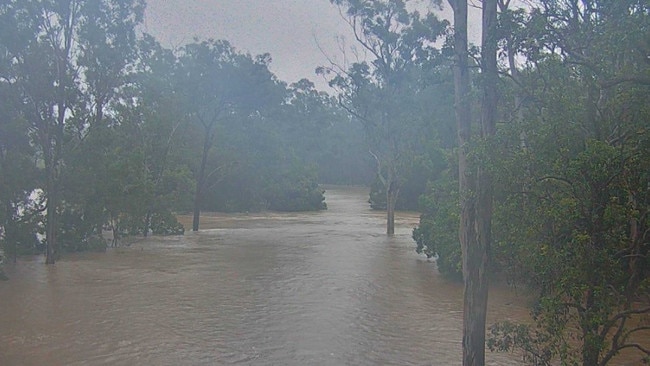Insurers hit with 12,000 claims in wake of record setting NSW floods
The nation’s insurers have received close to 12,000 claims following the record-breaking rains and devastating floods in NSW, with many more to follow.

The nation’s insurers have received close to 12,000 claims following the record-breaking rains and devastating floods in NSW, with “a large number more” expected in the coming days.
Most of the claims received to date are from the NSW mid-north coast towns of Port Macquarie, Kempsey, Laurieton, and Taree, and west of Sydney around Penrith and in the Hawkesbury-Nepean valley, the Insurance Council of Australia said on Tuesday.
“This remains an active natural disaster and it will take some time to gain a clearer picture of the damage,” Insurance Council chief executive Andrew Hall said.
“Insurers expect a large number of claims will be lodged in coming days as property owners begin returning to homes and businesses.”
While too early to estimate the cost of the damage, the ICA gave the February 2020 east coast storms and flooding event as a point of comparison. Insurers paid out close to $1bn in relation to that event.
Analysts have already warned that claims from the latest NSW and Queensland floods could eclipse last year’s $2bn bushfire payouts.
As insurers grapple with the rising claims, analysts are looking ahead, gauging the impact on reinsurance and share prices.
Morgan Stanley expects the catastrophe will add to reinsurance pricing pressure.
“Feedback from all reinsurers is (that) aggregate covers are proving costly, and we think this event adds to pressure for July renewals,” the broker told clients in a note.
The February 2020 storms were a similar event, but with stronger winds, the analysts noted.
For that flood event, the industry saw around $900m gross claims. However, IAG was capped at $135m by reinsurance and Suncorp at $155m.
Reinsurance sees insurers transfer portions of their risk portfolios to other companies, to protect against having to pay out large sums from insurance claims.
The fallout from the recent wild weather will see insurers tap their reinsurance cover, but they will need to wear some of the cost first.
IAG, which houses well-known brands NRMA, CGU and Swann Insurance, has a single event retention of $169m before reinsurance kicks in, with this reducing to $135m for a second event.
Suncorp, in comparison, has a per-event retention of $250m.
Floods rank as among the most costly events for insurers, given extensive damage to businesses and households that are impacted by rising waters. At the same time the number of traffic accidents also increases.
Improved flood mapping over the past decade means most major insurance now offer automatic cover for flood, rainwater run-off and storm surge.
Historical data
Going back more than 50 years, Macquarie analysts pulled the numbers on he largest Australian flood losses since 1967. These were: $2.4bn in 2010, $1.2bn in 2019, $578m in 1984, $509m in 1974 and $507m in 2008.
Finding that insurers typically trade broadly in-line with the market for the three months post perils, the analysts urged clients to look through the near-term pain.
“Although there is likely to be sticker shock should any announcement be made regarding these events, we encourage investors to look through any potential losses,” they said.
“Any weakness around a potential announcement could be viewed as a buying opportunity (all else being equal).”
Macquarie has maintained its outperform recommendation on Suncorp and its neutral recommendations for IAG and QBE.
At Goldman Sachs, analysts estimate that if the recent storms were to become “a large event” for IAG and reached its $169m first event maximum event retention, combined with the $200m of small event costs in the first half of the year, “before any other large events in the second half, IAG would land roughly at its fiscal 2021 allowance of $658m”.
“With around $100m of its fiscal 2021 aggregate deductible remaining … there is reasonable risk of an overshoot of its allowance,” they told clients.
In this case, the broker estimates earnings per share risk of 5-10 per cent, if there is another large event or a string of medium events. For Suncorp, the earnings risk is 5 per cent, they said.
Suncorp shares have dropped 3 per cent since Friday and on Tuesday were trading at $9.83, while IAG’s share price is down 1.4 per cent over the same period, to $4.77.
The major insurers have, for years, repeatedly warned on the likelihood of more severe, and more frequent, weather events.
IAG last year warned intense short duration rainfall would increase almost everywhere in Australia in the years ahead, resulting in more frequent flooding in urban areas and in small river catchments.
“Storm rainfall totals from both east coast lows and tropical systems are also expected to increase, leading to increasing flood risk in the larger river catchments,” the insurer said in its Severe Weather in a Changing Climate report.
The multi-day impacts of east coast lows on the south-eastern seaboard of Australia are expected to increase because of wind-driven rainfall ingress, flash and riverine flooding, IAG said.
“This effect will be compounded by rising impacts from storm surge, waves, and coastal erosion. Summer and autumn east coast low activity is expected to increase, while there will be a decrease in winter-spring systems.”
Suncorp, meanwhile, in its submission to the royal commission on natural disaster arrangements last April, called for the chronic shortfall in government funding for disaster resilience to be addressed.
“Successive governments have wrongly ignored the imbalance of spending 97 per cent of our disaster funding on recovery, and only 3 per cent on prevention and mitigation, the insurer said.
“Addressing this long-standing imbalance will help to strengthen regional economies, protect vulnerable communities, and put downward pressure on the cost of living via lower insurance premiums.”
Action needed to be taken at both a community level, such as the construction of flood levees, as well as at an individuals level, Suncorp said.
The insurer also called for the Productivity Commission’s 2014 recommendation for a five-fold ($200m per annum) increase in the level of Federal Government funding for disaster mitigation to be implemented and matched by the states and territories.







To join the conversation, please log in. Don't have an account? Register
Join the conversation, you are commenting as Logout